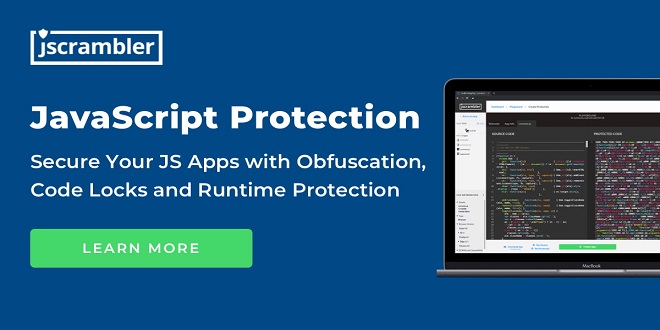JavaScript is a programming language with many useful features; it is designed to be flexible, giving you the ability to do whatever you want with it. The dynamic nature of JavaScript has become the de-facto browser language and the most popular programming language in the world.
Let’s read in detail-
One of the most useful JS features is immediate parsing. This feature implies that the browser executes the code as it downloads content, which naturally provides advantages. This level of freedom, however, comes with responsibility.
Here, we will look at JavaScript security risks and how to secure JavaScript code. We will only cover front-end code that runs in the browser this time, but we have another tutorial on protecting Node.js apps. If you’re looking to master web application development for virtually any computing platform, this Java Training is for you.
This article is intended to be educational, but the approach we’ll take is more of a fun game of cat-and-mouse than a practical, easy-to-implement approach.
Why is JavaScript protection through the libraries so prominent?
When developing JavaScript protection through the libraries, developers generally assume that the library’s user is well-intentioned. Most libraries are not designed to interact with malicious code, even if they may add runtime checks to APIs to prevent misuse.
But what if your users were malicious?
JavaScript is render-blocking, which gives it a significant advantage when it executes. This means that the browser will stop parsing, run JavaScript, and then continue. This gives you complete control over how you use this programming language and opens up the code to a plethora of possibilities.
The question is, however, what are the implications of such features when attempting to build secure JavaScript apps?
We may believe that we have adequately protected our password from the attacker, but they have a few tricks up their sleeves. There is a flaw in the function Object () {[native code]} function we have here. We tried to write code that would prevent the library from sending requests to domains other than example.com.
This is due to the multiple object property lookups we perform in our library code. When we run the type of check for the first time, the get is fired. The second get call is when we check to see if the string begins with a value. Each of these checks adds to the x counter.
You may have used script> tags to import third-party libraries as a frontend developer. Have you considered the security risks of doing so? Finally, the third-get call is made after we retrieve the value and assign it to the URL. The getter then returns the “mutated” value. JavaScript is now widely used. It works in both your browser and your backend.
Furthermore, JavaScript is a heavily reliant ecosystem on third-party libraries. As a result, securing JavaScript necessitates adhering to best practices in order to reduce the attack surface.
Yes, these are the kinds of things that can happen when you render external resources on your website. As a result, your website may be vulnerable to security threats.
One method is to prohibit extensions to the exported Sensitive instance. We have an entire article on this at JavaScript Object Property Descriptors, Proxies, and Preventing Extension, but we’ll just cover enough content here to secure our library.
There are a few approaches to preventing object extensions, but the most straightforward is to use Object. Freeze (). This method effectively disables the ability to mutate an object.
Do yourself a favor and never go around trusting anyone when writing code for web applications. At least in terms of data. A good validation architecture is an extremely important technique for avoiding JavaScript vulnerabilities.
Validate each and every field in the case of user input forms. SQL injections and XSS are becoming increasingly common these days. As a result, before saving the data to the server, ensure that you validate each and every field on the form.
It could be user-generated data. It could also be data from your servers. Always validate data before entering it into the application. Even if the data is saved on the servers, do not put your trust in them. Always sanitize the data that comes from servers.
If you are working on a node-based application, check out validator.js. It’s something you should get started with right away. One method used by hackers is to first attempt to understand your JavaScript code, which is readily available in browsers.
Minifying means removing extraneous characters from your JavaScript code. And to obfuscate is to change your JavaScript code in such a way that it is difficult to understand. You can be certain of one thing after they understand your code: your app is in jeopardy!
JavaScript is a dynamic and very flexible language. However, it bears repeating. JavaScript is a dynamic and adaptable programming language. And it is for this reason that developers can inadvertently introduce errors that can backfire on them.
Linting is a process in which someone keeps an eye on you and shouts at you if you write something that you are not supposed to. Except that it isn’t a real person, but rather a tool at your disposal.
More information on Linting in JavaScript can be found here. Linting, in a nutshell, is a process that analyses your code and alerts you if anything appears suspicious.
Furthermore, imagine you enabled the “automated security fix PRs” option. In that case, the monitoring section will send an automated PR to fix these issues while also addressing the security risks.
In a nutshell, strict mode generates more exceptions. It does not permit us to perform any risky actions, such as accessing and declaring global objects. Essentially, it ensures that your code is well-thought-out.
When programming in JavaScript, make sure the strict mode is turned on. Include “use strict” as the first statement in your JavaScript file to enable strict mode. App sealing developers will guide you with the functionalities and help you find the right sketches of your task to do the needful.
Strict mode, in a nutshell, generates more exceptions. It does not allow us to perform any potentially dangerous actions, such as accessing and declaring global objects. It basically ensures that your code is well-thought-out.
Read Also: Javascript Certification in Munich
Conclusion
When coding in JavaScript, make sure the strict mode is enabled. To enable strict mode, include “use strict” as the first statement in your JavaScript file. So, a simple rule to follow is to always minify and obfuscate your JavaScript code.
 BESTCITYTRIPS
BESTCITYTRIPS




